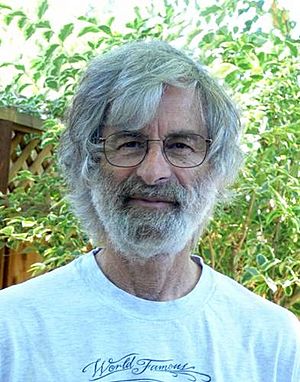Leslie Lamport facts for kids
Quick facts for kids
Leslie Lamport
|
|
|---|---|
 |
|
| Born | February 7, 1941 New York City, U.S.
|
| Education | |
| Known for |
|
| Awards |
|
| Scientific career | |
| Fields | Computer science |
| Institutions |
|
| Thesis | The analytic Cauchy problem with singular data (1972) |
| Doctoral advisor | Richard Palais |
Leslie B. Lamport (born February 7, 1941) is a famous American computer scientist and mathematician. He is best known for his important work on distributed systems. These are computer systems where many separate computers work together by sending messages to each other.
Lamport also created LaTeX, a special system for writing and preparing documents. He won the 2013 Turing Award, which is like the Nobel Prize for computer science. He earned this award for making clear rules for how distributed computer systems should work. His ideas helped make computer systems more correct, faster, and more reliable.
Contents
Early Life and School
Leslie Lamport was born in Brooklyn, New York. His family came from different parts of Europe.
He went to Bronx High School of Science, a special school for students interested in science. After high school, he studied mathematics at the Massachusetts Institute of Technology (MIT), getting his bachelor's degree in 1960. He then earned his master's and Ph.D. degrees in mathematics from Brandeis University in 1972.
Career and Discoveries
Lamport worked at several big technology companies. He was a computer scientist at Massachusetts Computer Associates from 1970 to 1977. Then he worked at SRI International from 1977 to 1985. After that, he joined Digital Equipment Corporation and Compaq until 2001. In 2001, he started working at Microsoft Research in California, where he retired in January 2025.
Understanding Distributed Systems
Lamport's research helped create the basic ideas for how distributed systems work. Imagine many computers needing to work together, even if they are far apart. Lamport figured out how to make them cooperate smoothly.
Some of his most famous ideas include:
- Logical Clocks: This helps computers in a distributed system agree on the order of events, even if their physical clocks are not perfectly in sync. It's like saying "event A happened before event B."
- Sequential Consistency: This idea makes sure that when many computers work on the same program, the results look like they happened in a simple, step-by-step order, even if they are actually happening at the same time.
- Byzantine Fault Tolerance: This helps systems keep working correctly even if some parts of the system fail or act in unexpected ways. It's like making sure a group of generals can agree on a plan, even if some of them are unreliable.
- Paxos Algorithm: This is a way for many computers to agree on a single decision, even if some of them stop working or send wrong information. It's used in many important online services.
- Bakery Algorithm: This helps multiple computer programs share the same resources without crashing. It's like a bakery where customers take numbers to make sure everyone gets served fairly.
- Digital Signature: Lamport also helped create early versions of digital signatures. These are like electronic fingerprints that prove who sent a message.
Creating LaTeX
In the early 1980s, Leslie Lamport started working on a new way to write documents using a system called TeX. He wanted to make it easier for people to create professional-looking papers and books.
He developed a set of tools called LaTeX. This system helps writers focus on their content, while LaTeX handles the formatting and design. In 1986, Lamport published the first user manual for LaTeX, which became very popular. Today, LaTeX is still widely used by scientists, engineers, and students around the world to write papers, theses, and books.
Temporal Logic and TLA+
Lamport also worked on something called temporal logic. This is a special kind of logic used to describe how computer systems behave over time. It helps engineers make sure that complex systems, like those in airplanes or power plants, will always work correctly and safely.
He created a language called TLA+. This language helps people describe and check how computer hardware and software systems should work. It's a way to use mathematics to build very reliable computer systems.
Awards and Recognitions
Leslie Lamport has received many important awards for his work.
- In 2013, he won the Turing Award. This award recognized his "fundamental contributions" to how distributed and concurrent computer systems work. His ideas helped create concepts like logical clocks and how systems can stay safe and active.
- He was chosen as a member of the National Academy of Engineering in 1991.
- In 2014, he became a Fellow of the Association for Computing Machinery (ACM).
- He has also received several honorary doctorates from universities in Europe.
- In 2008, he was awarded the IEEE John von Neumann Medal.
- In 2011, he was elected to the National Academy of Sciences.
See also
 In Spanish: Leslie Lamport para niños
In Spanish: Leslie Lamport para niños

